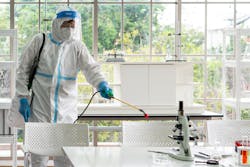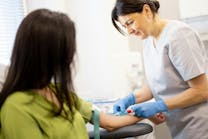Since the arrival of the SARS-CoV-2 virus, many regular routines that take place in the clinical lab have been directly affected, with daily cleaning and disinfecting practices at the top of the list. Established and existing protocols set in place by individual facilities and/or government agencies have been enhanced because of the seriousness of COVID-19, the disease caused by the SARS-CoV-2 virus, and its potential for infection, severe illness, and death. To date, there are over 13 million reported global cases of COVID-19 – a number that demands lab cleaning and disinfecting practices become a top priority in an effort to prevent as little further increase as possible.
Infection prevention and PPE
Two areas considered key to infection prevention among both lab and medical staff have always been the frequency of cleaning practices combined with the use of disposable personal protection equipment (PPE). With the devastating effects of COVID-19 already apparent on a worldwide scale, requirements for both PPE and cleaning frequency protocols have been increased to prevent new infections from occurring. However, one major challenge created by COVID-19 is the lack of readily available, single-use PPE, which has forced wearers to find secondary solutions for disinfection of daily-use items.
Dan Scungio, MT (ASCP), SLS, CQA (ASQ), better known as Dan The Lab Safety Man, pointed out, “With national shortages of PPE, such as isolation gowns, surgical masks, and N95 respirators, many organizations have had to move to methods which both prolong the use of such items and disinfect them – something that was not previously done with disposable or single-use products.”
He continued, “Processes like UV light sterilization and hydrogen peroxide mist treatments were tested and implemented in many organizations across the country. This brought forth the need for quality checks like respirator fit-testing and the use of biological indicators to ensure complete disinfection.”
Adding to Scungio’s comments, Kedar Patel, Senior Product Manager at Contec, noted, “The shortage of PPE (masks, gloves, gowns, etc.) has created many new temporary procedures. As an example, for Sterile Compounding Pharmacies, the FDA (U.S. Food & Drug Administration) issues guidance stating that in the event of PPE shortages, the facility should increase the frequency of cleaning and disinfecting – they also recommended the ‘judicious’ use of sporicidal disinfectants.”
Patel added, “The CDC (Centers for Disease Control and Prevention) issued a similar guidance for acute healthcare settings but added that ‘as PPE availability returns to normal, healthcare facilities should promptly resume standard practices.’”(Source: https://www.cdc.gov/coronavirus/2019-ncov/hcp/ppe-strategy/index.html)
In addition to PPE disinfection, new protocols also address the increased frequency of daily cleaning and disinfecting of “high-touch” surfaces. Patel defines high-touch, or frequently touched areas, as “common surfaces that multiple people can touch within a short period of time like door handles, lab refrigerator handles, phones, armchairs, etc.”
Kaumudi Kulkarni, MS, MSc, Senior Manager of Research and Development at Healthmark Industries, said, “Our R&D Laboratories are now getting cleaned and disinfected more frequently than before. Shared equipment is wiped with isopropyl alcohol after each use. During the middle of every workday, all high-touch surfaces in the labs get disinfected by wiping with isopropyl alcohol, and at the end of the workday, all work surfaces, equipment and lab tools are disinfected by the laboratory personnel. The facilities team then comes in and wipes the floors, blinds and top of the cabinets with a bleach solution.”
Changes to existing PPE protocols
One of the most common and important responsibilities for laboratory personnel is knowing when PPE protocols must be followed, and the duration of time that the PPE must be worn during any procedure or practice. With the heightened awareness of COVID-19’s rapid rate of infection, a higher emphasis has subsequently been placed on the wearing of PPE at all times by lab personnel. This change has left some lab managers and staff looking for guidance on what qualifies as PPE and what does not.
Kulkarni reported, “All laboratory personnel now wear face masks all the time in the labs and in the offices. All employees get a mandatory wellness screening before entering the premises. New face masks are required to be used every day, and face shields are made available to be used if needed.”
Offering more detail, Scungio explained, “Much has evolved in the past few months regarding PPE protocols in hospitals, and there has been a great deal of confusion for managers and lab staff as a result. Some facilities have moved to requiring staff to change clothes before leaving work if they have direct patient contact. In addition to usual PPE (lab coats, gloves, etc.), lab staff have moved to wearing face masks (N95 respirators in some hospitals) and goggles or face shields at all times. While it was considered normal to need face protection when a risk for splash existed, what was new was using face masks and face or eye protection at all times – even when leaving the lab in some locations.”
He continued, “Some facilities decided that cloth or homemade masks were not sufficient in areas where staff work closely together, so only surgical masks were permitted. Other facilities began to require masks for all staff whenever inside any part of the facility, even in clean areas such as cafeterias and hallways. In normal circumstances, OSHA (Occupational Safety and Health Administration) does not allow PPE used inside the lab to be taken out of the department. Under the new guidelines, are masks considered PPE? Can goggles or face shields be worn outside of the department? These are issues that have had to be addressed in many facilities.”
New normal for labs
In much the same way that COVID-19 shows no signs of stopping anytime soon, so do the new and enhanced lab protocols that are now being considered the new normal going forward, regardless of the finality of COVID-19 on a global basis.
Scungio asserts, “Most of the changes occurred due to shortages of disinfectant products and PPE. As some supplies slowly become more available, many organizations are reverting back to standard use and disinfection processes. When the next virus spike occurs, it is possible there will be another run on such products, but hopefully businesses will have a better handle on supply chain management going forward.”
Patel sums up, “These uncharted times have only heightened the vulnerability of facilities for disaster preparedness. Practices, protocols, and contingency plans are being developed, stressed, and challenged to ensure best chance for success. Based on adoption and procurement of consumables, we may be well on our way to a new ‘normal,’ and that much wiser for the next potential hurdle to be faced.”




